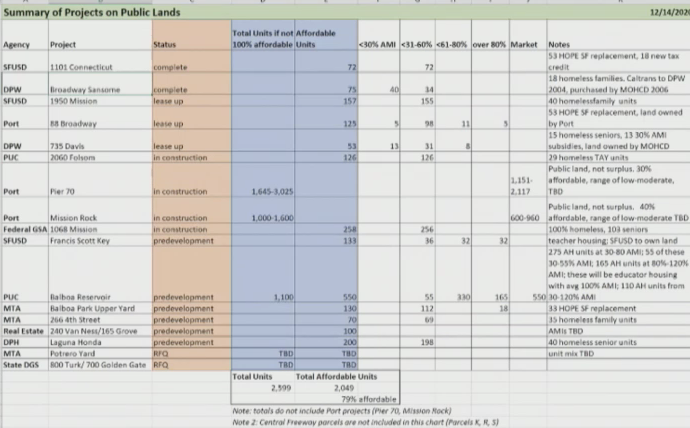Hello San Francisco. I'm attending a hearing of the San Francisco Board of Supervisors Land Use and Transportation Committee, watching an item on maximizing affordable housing on public land.
Supervisor Preston is starting things off.
Preston: "This is a topic we could spend quite a bit of time on." I want to start a conversation. I called for this hearing to maximize public housing on public sites, which is of central importance for people of all walks of life in SF
Preston: "This is a topic we could spend quite a bit of time on." I want to start a conversation. I called for this hearing to maximize public housing on public sites, which is of central importance for people of all walks of life in SF
Preston: Balboa Reservoir combined affordable and market-rate housing on public land, and I heard a lot of constituent questions on it. When I asked departments about including higher levels of affordable housing on public housing, they said it wasn't doable.
Preston: Balboa Reservoir led me to ask why we're building market-rate housing on public lands and how do we have more input earlier, before projects are presented to the Board? We want the most affordable housing possible on public land.
Preston: I believe MOHCD/OWED and the City's Real Estate Division are here. I'd like to pursue 3 areas of inquiry:
1. How do we got to 100% affordable on public land?
2. What are existing public sites which can have affordable housing?
3. How do we achieve more land banking?
1. How do we got to 100% affordable on public land?
2. What are existing public sites which can have affordable housing?
3. How do we achieve more land banking?
Supervisor Peskin: You're asking about a ground lease related to a fee simple conveyance. Is that part of your inquiry?
Preston: We can get into that and which structures create more affordable housing.
Peskin: "I might invoke Henry George before this is done."
Preston: We can get into that and which structures create more affordable housing.
Peskin: "I might invoke Henry George before this is done."
We're now going to the OWED presentation. Slides can be found here
https://sfgov.legistar.com/View.ashx?M=F&ID=9003559&GUID=14A2DE8D-0EFF-415E-8DE4-B9615BD01464
https://sfgov.legistar.com/View.ashx?M=F&ID=9003559&GUID=14A2DE8D-0EFF-415E-8DE4-B9615BD01464
Leigh Lutenski: Sites that are good candidates for 100% affordable housing have "fairly specific critieria": five stories, ~130 units
Peskin: How do we differentiate between surplus and 100% affordable candidates?
Lutenski: Projects are directed to MOHCD for eligibility.
Peskin: And departments must declare a property to be marked as surplus?
Lutenski: Yes
Peskin: And that land is mostly small useless?
A: Yes
Lutenski: Projects are directed to MOHCD for eligibility.
Peskin: And departments must declare a property to be marked as surplus?
Lutenski: Yes
Peskin: And that land is mostly small useless?
A: Yes
Lutenski: We start with the thesis of how much affordable housing we can build on a property, no matter how it comes to us.
Preston: For clarification, around the 10K sqft minimum, is that an ideal? I understand many parcels have 8K/9K sqft which could have ~60 units
Preston: For clarification, around the 10K sqft minimum, is that an ideal? I understand many parcels have 8K/9K sqft which could have ~60 units
Lutenski: It's because they're not ideal. We're looking for yield. A 10K sqft minimum is our guide, but not a hard line.
OEWD: Example of a good 100% affordable. project, 1950 Mission. Land originally owned mostly by SFUSD, with gap funding of $45M from MOHCD.
OEWD: Candidates for mixed-income sites usually have high site costs. A good example is Balboa Reservoir, 50% affordable, which needs new infrastructure and amenities. The $45M from MOHCD will fund 187 of the 550 affordable units [33%].
OEWD: There are a lot of departments involved in these projects. Formal solitication and community planning processes move in tandem. Once a project is determined, it needs EIR, permits, and then implementation.
OEWD: These processes include formal & informal processes. There's a public Request for Proposal with public meetings. And prior to environmental review, the Board weighs in on fiscal feasibility [Chapter 29]—opportunity before formal pre-development to weigh in.
OEWD: Public hearings provide more opportunities for input.
Peskin: Fiscal feasibility refers to Chapter 29? Asking as author of that section.
Lutenski: Yes.
Peskin: That's an early read by the board?
Lutenski: Yes, before CEQA.
Peskin: Fiscal feasibility refers to Chapter 29? Asking as author of that section.
Lutenski: Yes.
Peskin: That's an early read by the board?
Lutenski: Yes, before CEQA.
Peskin, facetiously: Who would have known that a piece of environmental legislation would have led to this public policy process?
OEWD: Reducing development costs would allow public subsidies to build more units.
End of the presentation.
End of the presentation.
Lutenski is joined by a number of colleagues from MOHCD, Real Estate Division, and Planning. Preston now going over questions.
Preston: I want to get context on the record. First, where we are on affordable housing on public sites in, say, the last 5 years. How many BMR units have we approved or built. on public land? How many market-rate units?
Lutenski: Lydia Ely from MOHCD is here and can also answer. We have a list of projects on public land in recent years. We have projects on SFUSD/MTA/Port/DPW/Real Estate/DPH surplus land. We've looked through City's landholdings. I'll total this up in a moment.
Lydia Ely: We have this information involving city/state/federal land. We've done 1,774 units to date on these lands that are complete.
Peskin: Can you break that down with the timeframe?
Peskin: Can you break that down with the timeframe?
Ely: Earliest project on this list is Broadway/Sansome.
Peskin: I was there when the earthquake happened, when Quentin Kopp turned those properties over to the City, and when Willie Brown build projects.
Ely: That site went Caltrans -> DPW -> MOHCD, roughly done in 2011.
Peskin: I was there when the earthquake happened, when Quentin Kopp turned those properties over to the City, and when Willie Brown build projects.
Ely: That site went Caltrans -> DPW -> MOHCD, roughly done in 2011.
Ely: That was oldest. Newest is project a 1068 Mission bought from the federal GSA for $1: 268 units for homeless individuals, 3 for seniors. We have a number of parcels with development agreement. Mission Rock, Pier 70, Balboa Reservoir, etc.
Peskin: And they're not 100% affordable?
Ely: Yes.
Preston: I wanted total numbers of BMR and market-rate since 2015. Is 1,774 the number of BMR units?
Ely: Yes, and it doesn't include Mission Rock and Pier 70.
Ely: Yes.
Preston: I wanted total numbers of BMR and market-rate since 2015. Is 1,774 the number of BMR units?
Ely: Yes, and it doesn't include Mission Rock and Pier 70.
Lutenski: Right, that doesn't include the port projects.
Preston: Where are we in RHNA goals? And what income levels do we need?
Ely: There's a RHNA update right now. We don't have final numbers or methodology yet. It looks like 72K units, 26% very low income, 15% low income, 16% moderate income.
Ely: There's a RHNA update right now. We don't have final numbers or methodology yet. It looks like 72K units, 26% very low income, 15% low income, 16% moderate income.
Ely: We need $4.4B just to meet low/very low income RHNA goals. Once the RHNA update is done, we expect to see a similar number.
Preston: So to meet RHNA goals, we'd need to build 72K units, with ~41K below market levels? Over what period of time?
Ely: I'll have to get back to you on that detail.
Ely: I'll have to get back to you on that detail.
Preston: On sources of funding, could you elaborate on the Housing Trust Fund? I believe we're capped at $15M annually?
Ely: It's one of the most flexible funding sources we have. We lost millions of ERAF dollars earlier this year and used trust fund to fill the gaps.
Ely: It's one of the most flexible funding sources we have. We lost millions of ERAF dollars earlier this year and used trust fund to fill the gaps.
Ely: For FY21-22 we expect $23M to come to the HTF next year. We have a few projects: for homeless units, families, COVID stabilization at MOHCD, and paying several million a year on debt servicing for the HTF.
Preston: Is that all committed?
Ely: Yes. About $3M will be left.
Preston: Is that all committed?
Ely: Yes. About $3M will be left.
Ely: Since COVID caused financial uncertainty in several sectors, it has reduced trust fund money coming in. And development in general is shaky. So we don't want to touch the remaining money in case we have more uncertainty.
Preston: How do you track where the money go?
Ely: We make quarterly reports on pipelines and expenditures, in addition to yearly reports.
Peskin: They're included in a huge stack of stuff the Board gets.
Ely: We make quarterly reports on pipelines and expenditures, in addition to yearly reports.
Peskin: They're included in a huge stack of stuff the Board gets.
Peskin: What I'd love to see is a breakdown of the ~1,700 units in a visual presentation. "That would be worth seeing."
Lutenski with OEWD has a 2-page spreadsheet to show with that data.
Lutenski with OEWD has a 2-page spreadsheet to show with that data.
Peskin: so units are entitled/in the pipeline/built. Can you sort this list by those categories?
Lutenski says that can be done later. [I suppose we won't see any real-time Excel magic today.]
Lutenski says that can be done later. [I suppose we won't see any real-time Excel magic today.]
Preston: It's interesting. I've been trying to piece together the step forward that the housing dashboard represents to the public. It begs the question of whether we need a dashboard for public sites.
https://sfmohcd.org/dashboards-and-data
https://sfmohcd.org/dashboards-and-data
Preston: I wanted to back to the issue of larger sites vs smaller sites in the presentation. Where is the dividing line for relying on market-rate development vs those where we don't? Are these guidelines written? Who makes those decisions?
Ely: It depends on our budget, which varies year to year. We're gearing up for a hard year next year. Inclusionary fees which come in a robust economy may not come in. "Our economy is variable" and subject to market forces.
Ely: When we work with OEWD and depts with public sites, we sometimes we have to look at how much can be funded based on finances available. We don't separate public and mixed-income funding.
Ely: We did an RFQ for 9 sites last week. It was mixed. We get a lot of land from developers, but there's a funding backlog. And this year, the state is awarding 4% bonds for the first time for housing projects. It may be devastating and cause projects to go on ice for a bit.
Preston: There are a set of decisions being made. In different situations, like Potrero Yards with 50%, there are different affordability requirements. It seems like on Project A 100% affordable is okay, on Project B mixed-income is fine. Who makes that decision?
OEWD: It is case-by-case, depending on the feasibility of each site. One major cost factor is the amount of infrastructure/amenities required for a site. The mixed-income case almost always arises for large sites, w/ high acreages needing multiple buildings.
OEWD: We leverage those with private investment to maximize affordable housing development.
MOHCD: In the Potrero Yards example, w/ multiple agencies involved w/ separate financial/use goals, decision has to made collaboratively and iteratively, so it's more complex.
MOHCD: In the Potrero Yards example, w/ multiple agencies involved w/ separate financial/use goals, decision has to made collaboratively and iteratively, so it's more complex.
Preston: So whose call is it? It sounds case-by-case based on what we can afford, but it's not happening legislatively.
Peksin: The real question is, enterprise agencies can choose to hang onto parcels with no future use in mind—do you have examples of that?
Peksin: The real question is, enterprise agencies can choose to hang onto parcels with no future use in mind—do you have examples of that?
Ely: I have no idea. We take the list that's put together every year. I don't know what doesn't get on the list.
Peskin: I do. Well, I don't have a complete view, but we're a huge landowner. I can speak to an SFMTA parcel—Kirkland Bus Division in Fisherman's Wharf.
Peskin: I do. Well, I don't have a complete view, but we're a huge landowner. I can speak to an SFMTA parcel—Kirkland Bus Division in Fisherman's Wharf.
Peskin: City spent a huge amount of money on studying pro formas and architectural options for the project and then decided to not pursue it. Why?
SFMTA rep: It came to a halt in 2009 and then was removed from surplus consideration.
Peksin: That's not true.
SFMTA rep: It came to a halt in 2009 and then was removed from surplus consideration.
Peksin: That's not true.
Peskin: They decided after the construction of the BRT, they needed a yard.
Rafe Rabalais [SFMTA]: SFMTA decided that Kirkland remains essential to our fleet purchasing plan.
Peskin: The larger question is how surplus site identification remains accountable.
Rafe Rabalais [SFMTA]: SFMTA decided that Kirkland remains essential to our fleet purchasing plan.
Peskin: The larger question is how surplus site identification remains accountable.
OEWD: It's up to each department to make the final determination what to do with their land.
Preston: If we're talking about enterprise agencies, I'm still curious about who's making that decision. I wonder if there's a policy or practical decision.
OEWD: It's always a collaboration. We start with the thesis of how much BMR we can yield.
OEWD: It's always a collaboration. We start with the thesis of how much BMR we can yield.
OEWD: There's a lot of agency-specific criteria for each parcel, guided by overall City policy.
Preston: Here's what's troubling me—I understand one may make the quickest/most affordable decision for one site. But you could maybe do a phased approach or different unit count?
Preston: Here's what's troubling me—I understand one may make the quickest/most affordable decision for one site. But you could maybe do a phased approach or different unit count?
Preston: You don't have a commission over you. Who makes the call as to whether a site could have 100% affordable units or not?
OEWD: It's not a single person in 1 department. E.g. for Balboa Reservoir, Supervisor Yee convened a Community Advisory Committee in 2015 before an RFP was ever issued. It was a community planning process.
Ely: In Sunnyvale/Potrero, there were projects with 100% public housing replacement, 25% more affordable units, and market-rate units which subsidize the affordable. Infrastructure being built by the affordable housing developers funded by MOHCD.
Ely: Genesis of that model goes back to Mayors Newsom/Lee. Many people were involved in that, including HUD. Downside of 20-year process is that market forces can shift. Living in a construction site for 20 years is not ideal and many residents have expressed that.
Preston: Has a model for 100% BMR or a phased approach in Potrero Yards been considered?
SFMTA: We looked at a phased approach for it. We explored w/ MOHCD. 1st priority is rebuilding the bus yard w/ capacity/seismic motivation.
SFMTA: We looked at a phased approach for it. We explored w/ MOHCD. 1st priority is rebuilding the bus yard w/ capacity/seismic motivation.
SFMTA: On 4.5 acres, we can't have a parcel which reserves specific land for any kind of housing development—bus yard takes up all footprint. Phasing would be extremely difficult. Building a bus platform would need best guesses for construction/utilities.
Peskin: Supe Preston, If I can get to your central question—and "I'm not a lawyer, but I play one on TV"—to the Deputy City Attorney, by ordinance, can this Board can dictate funds to departments which are not enterprise agencies?
While waiting for the answer, Supervisor Safai jumps in: A lot of people ask why we don't use public lands for 100% affordable housing [Francis Scott Key?]. One project that's gone through extensive design is educator housing. In that time, a lot of teachers have left the City.
Safai: I think a lot of projects come down to cost. Tax credits are the number one driver of affordable housing in the U.S., and those are getting more competitive with the state coming in.
Safai: In the Balboa example, we're talking about millions of $ in infrastructure costs which the City doesn't have, to build 550/1100 units as affordable. You could make it 100% affordable, but it would take a lot more time. And many families would be displaced in that time.
Safai: We have to talk about real tradeoffs. With Balboa, you leverage private money against public housing to get the project done in a more timely manner.
Peksin: Deputy City Attorney Anne Pearson has rejoined us.
He's re-asking the question he asked a few minutes ago.
He's re-asking the question he asked a few minutes ago.
Pearson: Your characterization sounds correct to me. As a general matter, enterprise agencies have exclusive jurisdiction over their property. Board jurisdiction is limited.
Peskin thanking her.
Peskin: Sup. Preston, if you wanted to set affordability requirements on City departments' land, we could do that. For enterprise agencies, we'd have to go to the City Charter.
Preston: Thanks, I wanted to get to the core of that question.
Peskin: Sup. Preston, if you wanted to set affordability requirements on City departments' land, we could do that. For enterprise agencies, we'd have to go to the City Charter.
Preston: Thanks, I wanted to get to the core of that question.
Preston: Sup. Safai, I think your assessment is correct. But I also want to recognize that there is a policy choice that we're defaulting into that we need to name: once there is an unspecified infra structure level, we go to the private market to make it pencil out.
Preston: It's often framed as feasibility, different than private investors' profit feasibility, related to what public dollars we're investing and where we're investing them.
Preston: Rather than doing projects which could deliver 100% BMR, it appears we're making policy/practical decision to build market-rate units. One option is to do phased projects, or to raise more money through bonds, taxes, etc.
Safai: The threshold varies over time. Mission Rock penciled at 40%, Balboa Reservoir at 50%, so it's an important piece of the conversation—what is the value statement on the City's behalf?
Safai: Related to Hope SF, there's a value in mixed-income communities. That shouldn't be lost.
Preston: It's an important point. But in SF with our AMIs, you can have income levels which cover a huge range. That can still occur with 100% below-market projects.
Preston: It's an important point. But in SF with our AMIs, you can have income levels which cover a huge range. That can still occur with 100% below-market projects.
Safai: I think you'll remember that when we started debate on inclusionary housing, the building trades were concerned about not being able to afford the housing they're building and commuting in from far away. They should be able to afford to live in SF.
Peskin: Ms. Ely talked about phased pro formas with decades of build-outs. We mostly don't have those because we're built out. Mission Bay, Treasure Island, [1–2 others] are the universe. After the economic downturn, Treasure Island didn't pencil.
Peskin: After I left the Board, they went to the Board and asked for more density. I tried to fight that case and went to the state supreme court, and they turned down my suit. Point is, I want to differentiate the different types of project options.
SFMTA: We're just one enterprise agency. When a project agreement/lease has to be signed, it goes before the BOS. Like Balboa Reservoir, we have a working group for Potrero Yards. We have regular monthly meetings with D9/10 offices and we offer briefings to the BOS.
SFMTA: The Potrero Yards issue is the joint development we're looking to pursue. The Budget & Legislative Analyst's Office suggested doing an early check-in with the BOS to get to some consensus.
Peskin: In the old Willie Brown days, the notion of an early read did not exist. I think that notion is a good thing. You said that SFMTA is an enterprise agency. Let's be clear—it's not really. It's largely dependent on BOS money, different from the SFPUC/airport/port.
Peskin: SFMTA is not truly an enterprise agency because it's reliant on General Fund money.
Preston: Let's talk about smaller sites. I wanted to talk about current strategy with acquiring improved land or other sites.
Ely, MOHCD: We acquire a lot of land through IZ and jobs-housing linkage fees, e.g. when developers don't include affordable units in projects.
Ely, MOHCD: We acquire a lot of land through IZ and jobs-housing linkage fees, e.g. when developers don't include affordable units in projects.
Ely: We typically don't do loans until we have funds available. We also look at how competitive projects will be for sources of funding.
Preston: Let's set land dedication aside. Let's talk about what we buy on the market.
Preston: Let's set land dedication aside. Let's talk about what we buy on the market.
Preston: E.g. in my district, 730 Stanyan was identified by Ed Lee and London Breed. How do we identify land for 100% affordable housing?
Ely: There are certain high-profile projects which are identified as a source of concern by community members. So when 730 Stanyan became available, there was urgency to make a decision. It's a point-in-time assessment: do we have the money?
Ely: There are many times parcels go away—it's a long list. And sometimes, requests to acquire land come from the Mayor, supervisors, or the community. Qs like does it meet community need? What kind of folks can we house? Possible funding sources for projects?
Preston: Do we have a set budget for acquiring land for BMR development?
Ely: No, except for this year where we identified sites in D1 and D4 in response to concerns that we don't develop enough land Citywide. Two sites: one on Geary, one on Irving.
Ely: No, except for this year where we identified sites in D1 and D4 in response to concerns that we don't develop enough land Citywide. Two sites: one on Geary, one on Irving.
Preston: But yearly, there's no set fund for that purpose?
Ely: Correct. Sometimes it's a question of getting inclusionary fees suddenly, which are subject to market forces.
Ely: Correct. Sometimes it's a question of getting inclusionary fees suddenly, which are subject to market forces.
Preston: Is the City proactively looking for land?
Ely: No.
Preston: When a property goes up for sale, is the City notified as part of COPA or otherwise?
Ely: If there are multifamily buildings available for sale, a list of non-profits is informed, given right of 1st refusal.
Ely: No.
Preston: When a property goes up for sale, is the City notified as part of COPA or otherwise?
Ely: If there are multifamily buildings available for sale, a list of non-profits is informed, given right of 1st refusal.
Preston: Is there a countercyclical acquisition strategy?
Ely: We keep waiting for land prices to go down, and we don't see that. We have to be very judicious about what acquisitions we attain, and we're not seeing prices go down. We see same thing in Chicago, LA, etc.
Ely: We keep waiting for land prices to go down, and we don't see that. We have to be very judicious about what acquisitions we attain, and we're not seeing prices go down. We see same thing in Chicago, LA, etc.
Preston: I hope Prop I may be used for a more defined pool of funds for land acquisitions. It seems to be very hard to pin down funding for it.
Preston: I want to go back to surplus properties. My understanding of the process is that there's an annual report provided to MOHCD. Has there been an annual list given to MOHCD/BOS every year since Prop K in 2015?
Ely: I see updated tallies for each year. This year the report timeline was delayed by COVID-19, but we have a good track record in getting reports.
Peskin: Have those reports been timely ever year?
Peskin: Have those reports been timely ever year?
Andrico Penick, Real Estate Division: Yes, this year the report was delayed due to the pandemic. Most of our staff are working remotely. March was a hard month.
Preston: The piece that appears to be missing is a lack of BOS hearing, except after Prop K. My understanding is that around April 15 the Board has a hearing. Has that been waived? Is the issue subsumed in other hearings?
Peskin: It's largely subsumed by hearings on the housing balance report. It's dealt with under that.
Penick: The Real Estate Division stands ready to give a presentation to the Board at your request. Our practice has been to give a report to you. We could present it.
Preston: I understand that the Board President can waive the hearing. Looking at the list, it looks like most are exempted, so there's only 1 surplus property listed right now. I could understand if President Yee thought a hearing on it isn't necessary.
Preston: I think it would be valuable, if beyond the scope of this hearing, to look at which properties are underutilized.
Penick: Like you said, it's largely up to department heads. At the Real Estate Division, we buy, sell, and lease, but we don't program land. Departments may say, it doesn't look utilized to you, but it is.
Preston: Dir. Penick, to my Qs around proactively identifying sites for purchase, does your dept do that? If a vacant parking lot in my district goes on the market, can you do that?
Penick: It is within scope, but the process is not as formalized as you might like.
Penick: It is within scope, but the process is not as formalized as you might like.
Penick: I get unsolicited calls to purchase property on a daily basis. I'm nearly always the first call of brokers. We get initial info about properties and send it to depts to gauge interest about use, like safe sleeping, safe parking, shelter, DPH clinics, City office space.
Penick: When depts tell me they have a need, I match. sites as they come in the door.
Peskin: It might be good say who you don't get real estate for.
Penick: I don't get requests from the airport, SFPUC, rarely the SFMTA. They concern themselves with their own real estate needs.
Peskin: It might be good say who you don't get real estate for.
Penick: I don't get requests from the airport, SFPUC, rarely the SFMTA. They concern themselves with their own real estate needs.
Preston: Despite all the debate around by-right and private development and Prop E, these small sites are real opportunities, though not necessarily high profile ones.
Penick: Over my tenure as director, the Board has made clear they prefer purchase over lease. It's a question of prioritizing resources.
Preston: On land dedication—those aren't subject to rules around enterprise departments, right? What is our policy as to 100% and mixed-income uses for those?
Ely: We do feasibility studies on capacity, toxicity, land grade issues, then write a preliminary acceptance level.
Ely: We do feasibility studies on capacity, toxicity, land grade issues, then write a preliminary acceptance level.
Ely: To date we aren't turning down any land dedications. We're celebrating our first project on a land dedication 1296 Shotwell. To date we have a list of 6/7 dedicated parcels, all 100% affordable. We may go up to 80% AMI, but no projects with market-rate units.
Preston: That's regardless of size.
Ely: Correct. Our largest is 801 Brannon, which we're using for COVID-19. The other larger site we've preliminarily accepted is 1979 Mission. It's too early to predict programming/financing for it.
Ely: Correct. Our largest is 801 Brannon, which we're using for COVID-19. The other larger site we've preliminarily accepted is 1979 Mission. It's too early to predict programming/financing for it.
Preston: What's the unit count for the accepted sites?
Ely: I see 208 units on 7th St, not sure about 1979 Mission.
Ely: I see 208 units on 7th St, not sure about 1979 Mission.
Ely: I think 1979 Mission will be 200-ish units. Best practice is not to have hundreds of units in a single building due to financing caps and operations.
Peskin: I have a meeting come up. Can we go to public comment? Sup. Preston, I don't want to truncate your questions.
Preston: We can. It's fine if we want to continue this to the call of the chair.
Preston: We can. It's fine if we want to continue this to the call of the chair.
Peskin: I've been in many incarnations of this commitee "and fired once by... somebody." Even though we come from different political stripes, I want to thank all the committee members. for this hearing.
The BOS clerk is introducing the Spanish-language interpreter for public comment, who specifies parameters for public comment in Spanish.
I won't transcribe all public comment due to time constraints. Thanks for reading this far.
During public comment, Sup. Peskin asks Sup. Preston to define social housing.
Preston: It includes not just municipal housing. It's an umbrella term for housing which is completely off the. speculative market, including community land trusts.
Preston: It includes not just municipal housing. It's an umbrella term for housing which is completely off the. speculative market, including community land trusts.
Public comment is over.
Peskin is asking Lydia Ely for another go at the recent list of affordable housing units built on public land. She says that the full count is 2,049 units. Peskin makes a comment about MOHCD knowing about this hearing for over a week & being unprepared.
Peskin is asking Lydia Ely for another go at the recent list of affordable housing units built on public land. She says that the full count is 2,049 units. Peskin makes a comment about MOHCD knowing about this hearing for over a week & being unprepared.
Peskin: Is there a site where the public can access this info?
MOHCD: We maintain a housing pipeline but it doesn't contain data about how sites come to the City.
MOHCD: We maintain a housing pipeline but it doesn't contain data about how sites come to the City.
Preston: If you're interested in how we're using public sites, it's very hard to parse that information here. I'd like to make closing comments if that's okay.
Sup. Peskin makes a joke about how nice it is that SF gained 250 units on public land between the start of public comment and now.
Preston: "I believe public land should be used for public good." We need to prioritize land for homeless and low-income folks, and helping priced out residents return to the City.
Preston: At some point a decision is made whether to deliver 100% BMR or some mix of market-rate units which are generally unaffordable to the working class. We need to improve transparency about those decisions. It sounds like we're doing better with smaller sites.
Preston: We need to get as much money as possible. If we don't have the money, we can't afford to create it. We've done it with bond money, but those amounts haven't been big and bold enough, esp. with federal cuts.
Preston: In the past cycle, my office has proposed Prop I for rent relief and affordable housing. It passed with a wide module. It's more flexible than federal funds [because the money goes through the General Fund].
Preston: Folks earning the most need to pay their fair share. Right now it's not even close. Prop I is a step in the right direction. But we're not on track to meet our RHNA goals. We'd need 57% of our housing production to be affordable. We're not even at half that.
Preston: Public sites offer an important opportunity to build housing people need and meeting our RHNA goals. And thank to Sup. Peskin for suggesting we need a public lands dashboard. The public needs more information and clarity around criteria.
Preston: We need to know what options for land are considered and rejected, etc. We also need more information in the public lands report. It's not just about surplus land, but also looking at underutilized public sites.
Preston: I plan to request a hearing to review surplus lands and review what land the City owns, so we can have public input on specific sites.
Preston: This hearing confirmed something I feared: there's no strategy for active acquisitions of land or property. I want to develop a robust strategy for land banking, which can be used in a downturn.
Preston: There remains a lot to be discussed and followed up on. So I'd like to make a motion that this item be continued to the call of the chair.
Peskin: If Sup. Safai has no further comment [he's barely spoken...?], do we need to keep this item alive?
Peskin: If Sup. Safai has no further comment [he's barely spoken...?], do we need to keep this item alive?
After some back and forth, Sup. Peskin says he'd like to keep the item alive.
Safai: Thanks to everyone who's called in. We often say 'housing for the working class,' and when you get into the area median income requirements you get into who's being included.
Safai: Thanks to everyone who's called in. We often say 'housing for the working class,' and when you get into the area median income requirements you get into who's being included.
Safai: Before I was even sworn in, the community and I were meeting to talk about making BMR projects happen. We're about to break ground on both BMR projects in the pipeline for D11—one on SFMTA/BART land [Upper Yard] and one bought by MOHCD.
Safai: I think the comments from D11 constituents should be considered among the public comment.
Peskin: I'd like to make a motion to continue this to the call of the chair.
Peskin: I'd like to make a motion to continue this to the call of the chair.
Motion passes unanimously.
That's it for today. Thanks for reading.

 Read on Twitter
Read on Twitter
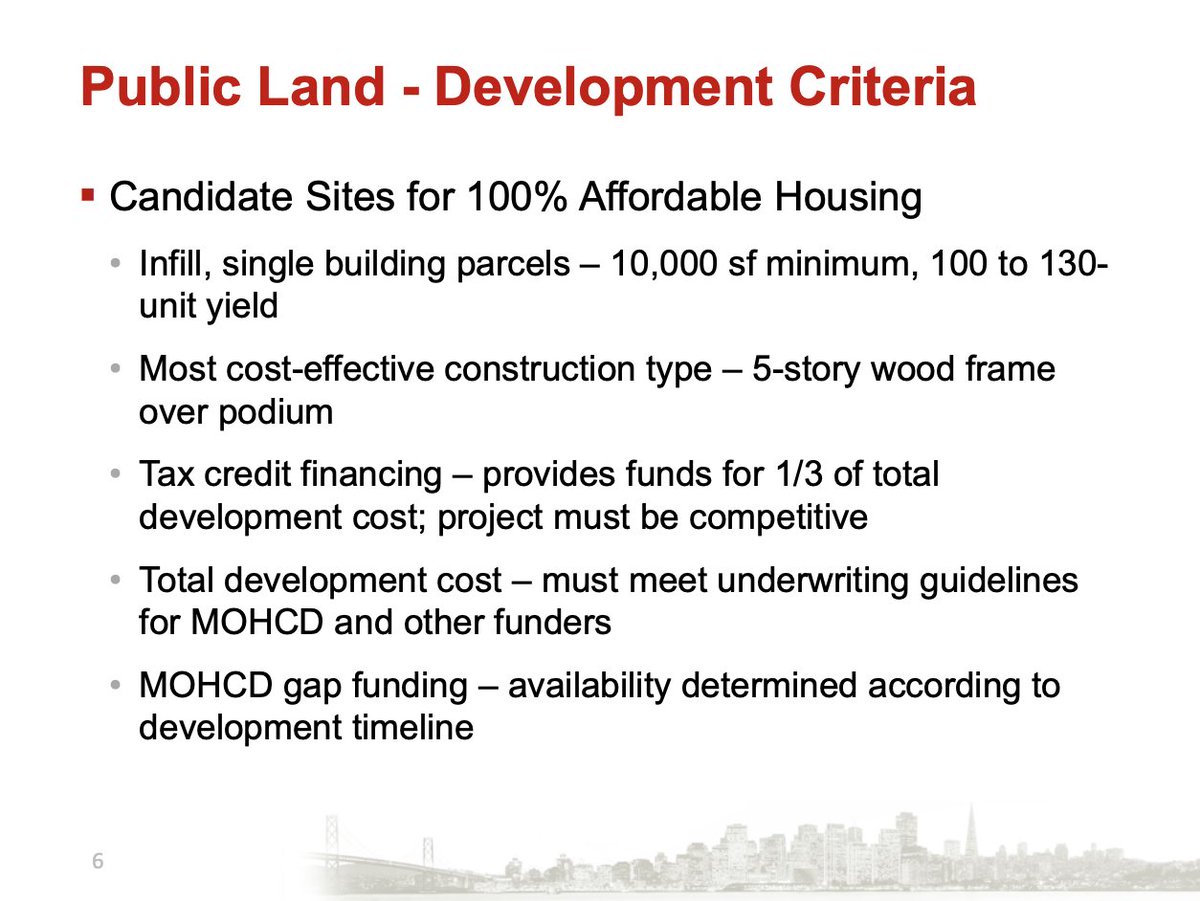
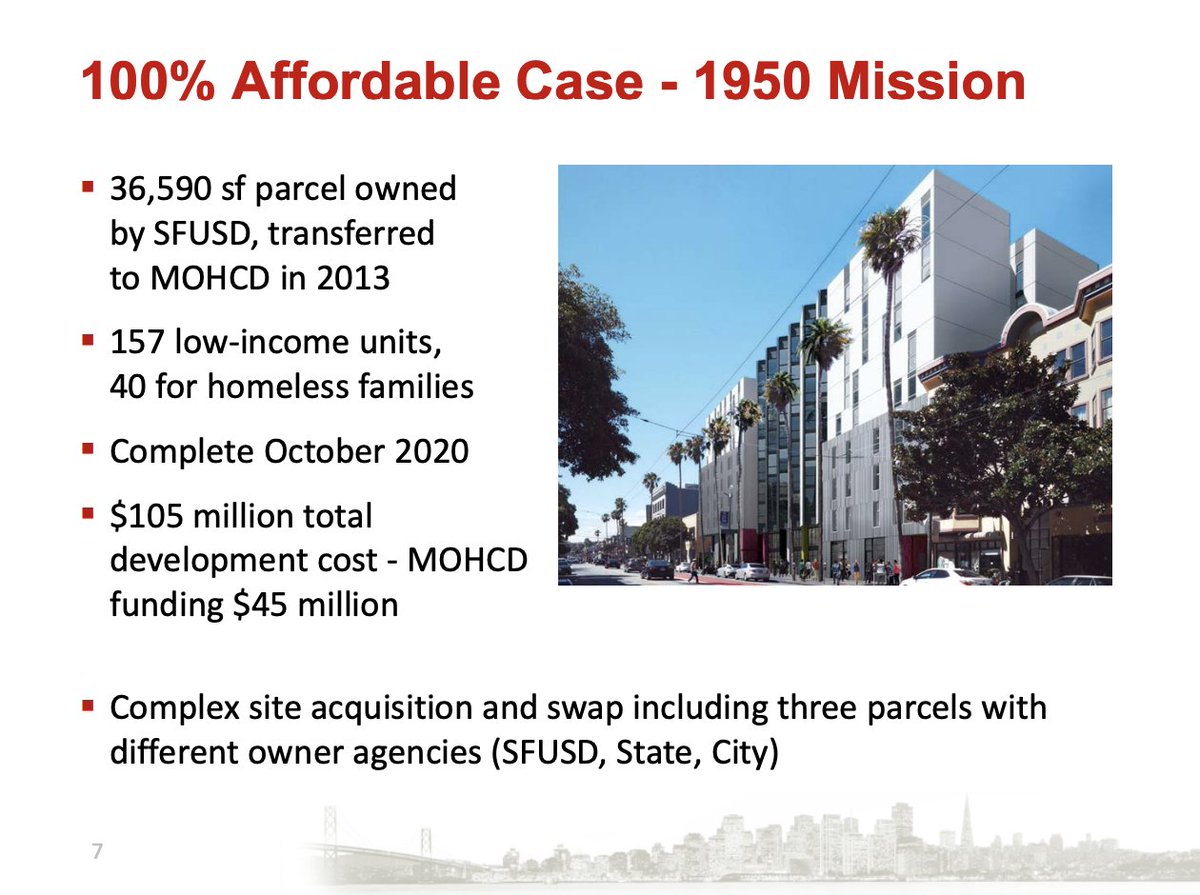
![OEWD: Candidates for mixed-income sites usually have high site costs. A good example is Balboa Reservoir, 50% affordable, which needs new infrastructure and amenities. The $45M from MOHCD will fund 187 of the 550 affordable units [33%]. OEWD: Candidates for mixed-income sites usually have high site costs. A good example is Balboa Reservoir, 50% affordable, which needs new infrastructure and amenities. The $45M from MOHCD will fund 187 of the 550 affordable units [33%].](https://pbs.twimg.com/media/EpOvnz8UUAErn-D.jpg)
![OEWD: Candidates for mixed-income sites usually have high site costs. A good example is Balboa Reservoir, 50% affordable, which needs new infrastructure and amenities. The $45M from MOHCD will fund 187 of the 550 affordable units [33%]. OEWD: Candidates for mixed-income sites usually have high site costs. A good example is Balboa Reservoir, 50% affordable, which needs new infrastructure and amenities. The $45M from MOHCD will fund 187 of the 550 affordable units [33%].](https://pbs.twimg.com/media/EpOvyhBUYAAlxpC.jpg)
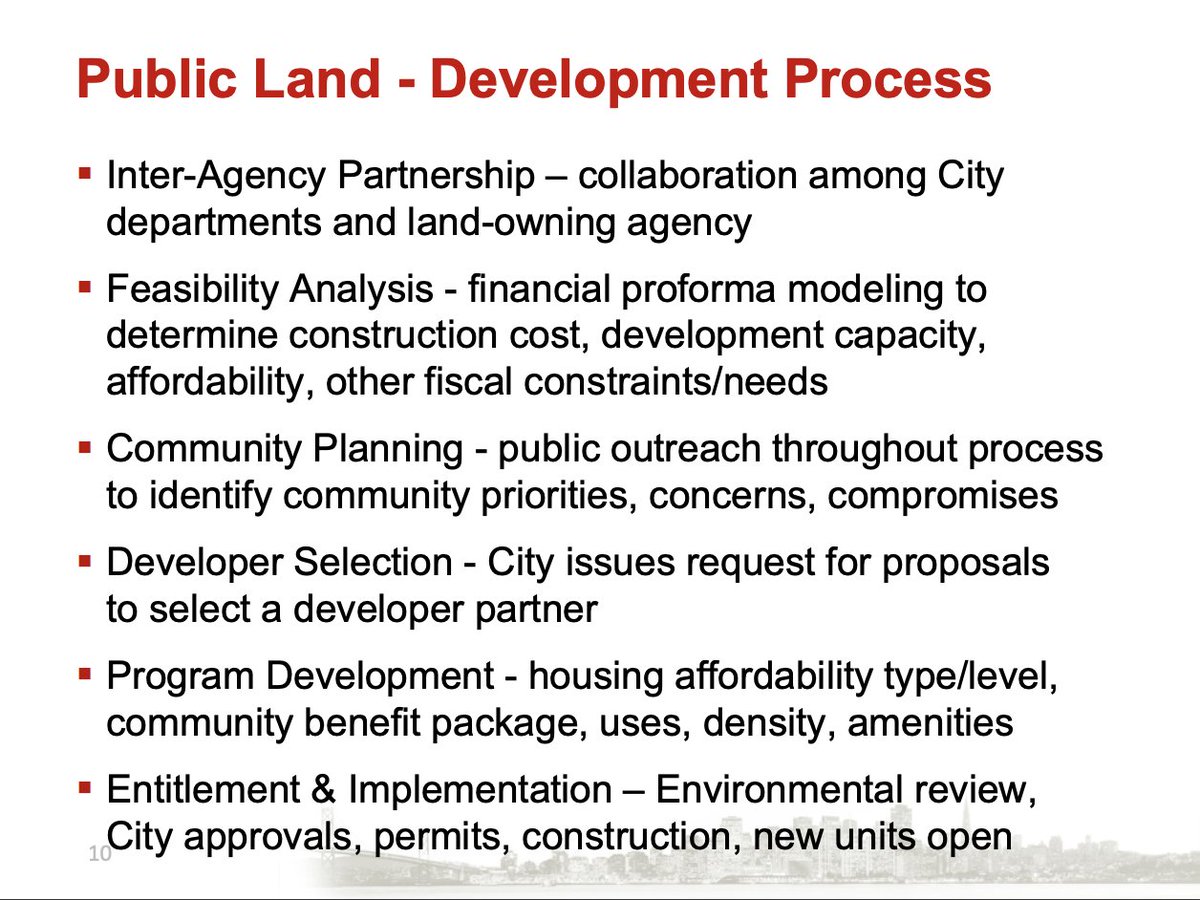
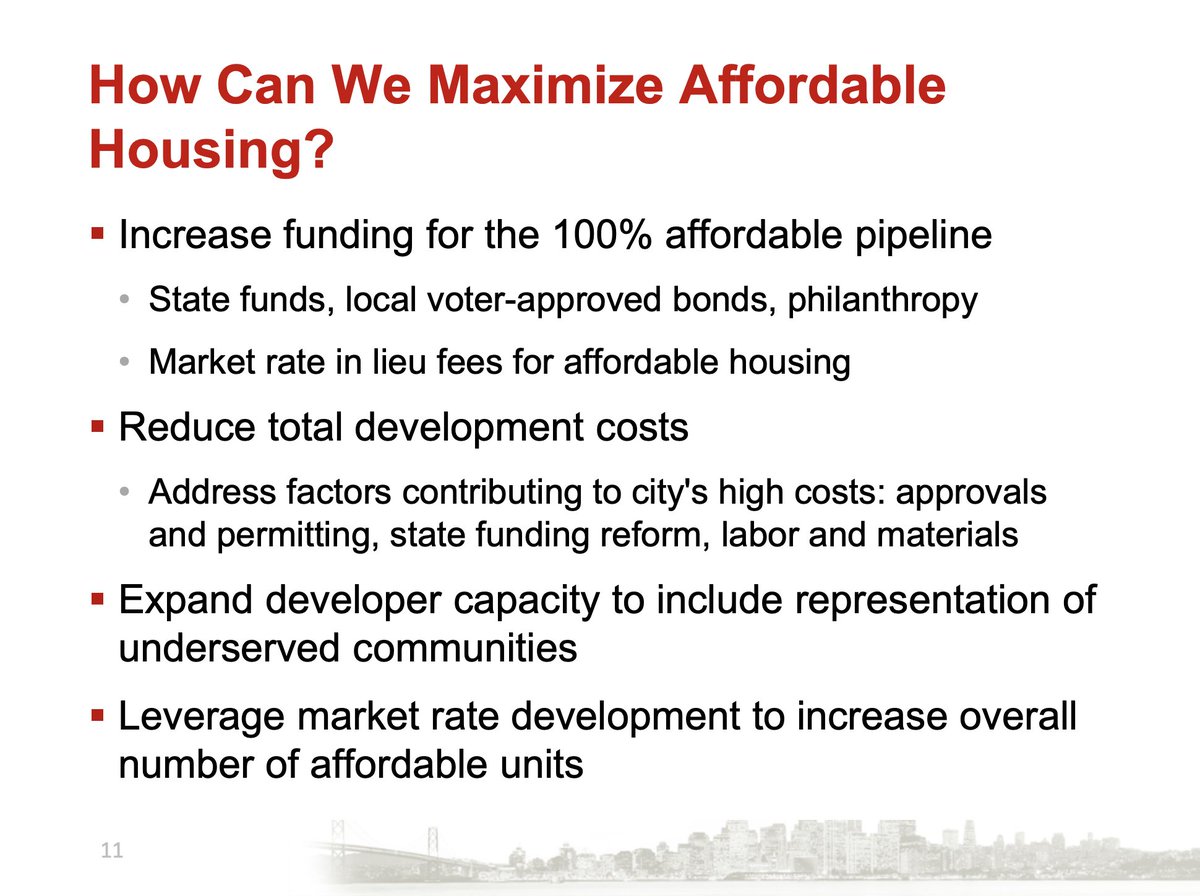
![Peskin: so units are entitled/in the pipeline/built. Can you sort this list by those categories?Lutenski says that can be done later. [I suppose we won't see any real-time Excel magic today.] Peskin: so units are entitled/in the pipeline/built. Can you sort this list by those categories?Lutenski says that can be done later. [I suppose we won't see any real-time Excel magic today.]](https://pbs.twimg.com/media/EpO1NZIVgAAnsZc.jpg)

